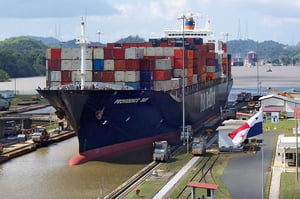Panama Canal Nearing Completion
 I can hear the choirs singing, “Soon and very soon…!”
I can hear the choirs singing, “Soon and very soon…!”
Rather than singing about seeing the King, they’re singing about seeing the completed Panama Canal expansion. And the completed expansion could very well affect which coast is king of international shipping in the U.S.
But let’s not get too far ahead of ourselves. I’ll talk about the completed expansion’s effects on international shipping in an upcoming section. First, let’s look at just how close the Panama Canal expansion is to being finished.
Drewry reports, “the Panama Canal Authority (ACP) stated [the project to widen the canal] was 89.8% done as of the end of May…”
The Miami Herald reports that the Panama Canal expansion is expected to be complete and open to commercial traffic in April 2016.
I suppose April of next year seems a little ways away–and it is about 2 years behind schedule–but considering the expansion was approved in 2006 and work began in 2007, a little less than a year is a very little ways away.
Earlier this month, the filling of the Atlantic side locks took place. Drewry reports, “Filling of the Pacific side locks is now underway, at a rate of 37,000 gallons of water per minute. It is expected to take 90 days.”
The Miami Herald helps give a feeling of just how exciting it is to be at the point of filling the Panama Canal locks with water:
“Filling the locks with water is the culmination of arduous years of labor and the realization that we are within arm’s reach of completion of one of the most impressive infrastructure projects of our time,” said Jorge L. Quijano, chief executive and administrator of the canal authority.
Here are some quick reference numbers on the Panama Canal expansion:
- Panama Canal Expansion Costs: $5.25 Billion
- Panama Canal Expansion Approved: 2006
- Panama Canal Expansion Begins: 2007
- Panama Canal Expansion Ready for Commercial Traffic: 2016
Purpose of the Panama Canal Expansion
The title of the Drewry article quoted above is “Carriers Jostling for Expanded Panama Canal Positions”. You would expect carriers to be drooling over the Panama Canal expansion with their bigger container ships.
Of course, the expansion of the Panama Canal was not originally meant just to allow bigger ships to pass through. The original purpose of the Panama Canal expansion was to increase its capacity, which was beginning to hit its limits creating long queues of ships.
The Miami Herald reports:
But with the trend of carriers moving toward larger ships, the expansion of the Panama Canal is even more important than originally thought.
Panama Canal Expansion Effect on Shipping
There’s a shift that’s been happening in cargo market share from the U.S. West Coast to the U.S. East Coast and the Panama Canal Expansion is expected to increase that market share shift.
Since January 2013, traffic from Asia to USEC has grown by 26% whereas Asia to USWC volumes have grown much more modestly at around 6%. Asia-US Gulf Coast demand trumps them both, growing at just over 40% but it comes off a very low base and has barely shifted the GC share much beyond 2%, according to Drewry.
The US West Coast remains by far the most widely used gateway for Asian container imports but its share is dwindling quite rapidly. At the start of the century the split was more like 84% USWC to 16% USEC but the later coast has nearly doubled its share in 15 years. The transfer of cargo seems to be intensifying too. Since January 2013 the USWC’s share has fallen from 73% to 69%, while the USEC has gained those four percentage points to reach 29%.
Yeah, there are a lot of numbers and percentages in there, but the message is easy to see. East Coast ports have been taking market share from West Coast ports. Recent slowdowns during the International Longshore & Warehouse Union’s (ILWU) contract negotiations helped many shippers to lose faith in West Coast ports and move shipments to the East Coast, increasing that market share shift.
The Panama Canal expansion will make it even easier for shippers to move their imports and exports from West Coast ports to East Coast ones.
Pretty big shifts in market share are expected by 2020. World Maritime News continues:
Up to 10 percent of container traffic to the US from East Asia could shift from West Coast ports to East Coast ports by 2020, according to a new research conducted by The Boston Consulting Group (BCG) and C.H. Robinson.
In 2014, about 35 percent of container traffic from East Asia to the US arrived at East Coast ports. According to the report, current growth trends would push that share to 40 percent by 2020 without the canal’s expansion. But with the canal expansion in place, the East Coast’s share could reach 50 percent — a 10 percent increase in market share.
East Coast ports have to be excited about the Panama Canal expansion almost being complete. For them, it can’t finish fast enough. West Coast ports are probably feeling the exact opposite way about the Panama Canal expansion completion.

